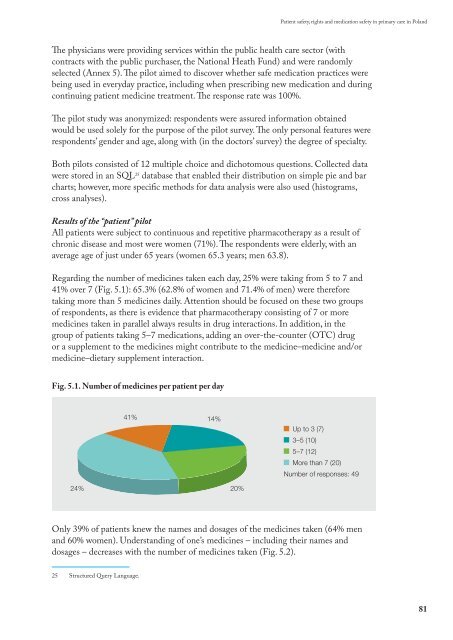Exploring patient participation in reducing health-care-related safety risks
Exploring patient participation in reducing health-care-related safety risks
Exploring patient participation in reducing health-care-related safety risks
You also want an ePaper? Increase the reach of your titles
YUMPU automatically turns print PDFs into web optimized ePapers that Google loves.
Patient <strong>safety</strong>, rights and medication <strong>safety</strong> <strong>in</strong> primary <strong>care</strong> <strong>in</strong> Poland<br />
The physicians were provid<strong>in</strong>g services with<strong>in</strong> the public <strong>health</strong> <strong>care</strong> sector (with<br />
contracts with the public purchaser, the National Heath Fund) and were randomly<br />
selected (Annex 5). The pilot aimed to discover whether safe medication practices were<br />
be<strong>in</strong>g used <strong>in</strong> everyday practice, <strong>in</strong>clud<strong>in</strong>g when prescrib<strong>in</strong>g new medication and dur<strong>in</strong>g<br />
cont<strong>in</strong>u<strong>in</strong>g <strong>patient</strong> medic<strong>in</strong>e treatment. The response rate was 100%.<br />
The pilot study was anonymized: respondents were assured <strong>in</strong>formation obta<strong>in</strong>ed<br />
would be used solely for the purpose of the pilot survey. The only personal features were<br />
respondents’ gender and age, along with (<strong>in</strong> the doctors’ survey) the degree of specialty.<br />
Both pilots consisted of 12 multiple choice and dichotomous questions. Collected data<br />
were stored <strong>in</strong> an SQL 25 database that enabled their distribution on simple pie and bar<br />
charts; however, more specific methods for data analysis were also used (histograms,<br />
cross analyses).<br />
Results of the “<strong>patient</strong>” pilot<br />
All <strong>patient</strong>s were subject to cont<strong>in</strong>uous and repetitive pharmacotherapy as a result of<br />
chronic disease and most were women (71%). The respondents were elderly, with an<br />
average age of just under 65 years (women 65.3 years; men 63.8).<br />
Regard<strong>in</strong>g the number of medic<strong>in</strong>es taken each day, 25% were tak<strong>in</strong>g from 5 to 7 and<br />
41% over 7 (Fig. 5.1): 65.3% (62.8% of women and 71.4% of men) were therefore<br />
tak<strong>in</strong>g more than 5 medic<strong>in</strong>es daily. Attention should be focused on these two groups<br />
of respondents, as there is evidence that pharmacotherapy consist<strong>in</strong>g of 7 or more<br />
medic<strong>in</strong>es taken <strong>in</strong> parallel always results <strong>in</strong> drug <strong>in</strong>teractions. In addition, <strong>in</strong> the<br />
group of <strong>patient</strong>s tak<strong>in</strong>g 5–7 medications, add<strong>in</strong>g an over-the-counter (OTC) drug<br />
or a supplement to the medic<strong>in</strong>es might contribute to the medic<strong>in</strong>e–medic<strong>in</strong>e and/or<br />
medic<strong>in</strong>e–dietary supplement <strong>in</strong>teraction.<br />
Fig . 5 .1 . Number of medic<strong>in</strong>es per <strong>patient</strong> per day<br />
24%<br />
41%<br />
Only 39% of <strong>patient</strong>s knew the names and dosages of the medic<strong>in</strong>es taken (64% men<br />
and 60% women). Understand<strong>in</strong>g of one’s medic<strong>in</strong>es – <strong>in</strong>clud<strong>in</strong>g their names and<br />
dosages – decreases with the number of medic<strong>in</strong>es taken (Fig. 5.2).<br />
25 Structured Query Language.<br />
14%<br />
20%<br />
Up to 3 (7)<br />
3–5 (10)<br />
5–7 (12)<br />
More than 7 (20)<br />
Number of responses: 49<br />
81



